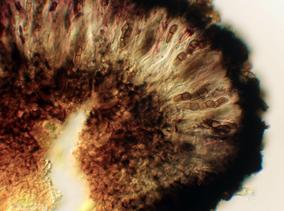You are here
All Fungi
Abrothallus caerulescens
Nomenclature
-
Family: AbrothallaceaeGenus: Abrothallus
SUMMARY
Mycelium: immersed in the host thallus, staining blue with iodine.
Anamorph: conidiomata pycnidia, black, immersed or with the upper third erumpent, ostiolate. Conidiomatal wall 20-35 µm thick, pale brown below and dark brown around the ostiole. Conidiogenous cells 10-17 x 3-4.5 µm, elongate ampulliform to ± cylindrical. Conidia 7-14 x 4.5-6.5 µm, ellipsoidal, distinctly truncate at the base, aseptate, hyaline to pale yellow, ± smooth-walled.
Teleomorph: ascomata apothecia, erumpent through the host thallus, 150-400 µm diam. and 80-150 µm high, pulvinate, the upper surface shallowly to strongly domed, dark brown to black. Epihymenium composed of dark greenish brown granules. Hymenium pale brown to pale green, the pigmentation intensifying green in K. Hypothecium dark reddish brown, composed of angular cells covered with brown pigment. Interascal tissue of fairly thick-walled frequently branched hyaline paraphyses 2.5-3.5 µm diam., the apex rounded and sometimes slightly broadened. Asci 55-70 x 12.5-16.5 µm, clavate to cylindric-clavate, fairly short-stalked, the apex rounded, thick-walled and fissitunicate with rostrate dehiscence, with a pronounced apical cap and narrow ocular chamber, not staining in iodine, 8-spored. Ascospores 11–14 × 5.5–6.5 µm diam., rather variable in length/breadth ratio, 1-septate, the upper cell broader and ellipsoidal to cylindric-ellipsoidal, the lower cell cylindrical to conic-cylindrical and narrower, constricted slightly at the septum, the apex obtuse to rounded and the base acute to obtuse, dark brown, brown, thick-walled, strongly verrucose, without an epispore, gelatinous sheath or appendages.






